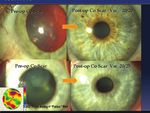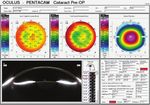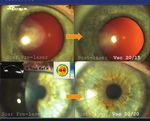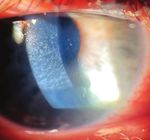CORNEAL HAZE AFTER PRK ENHANCEMENT OF PRIOR LASIK
←
→
Page content transcription
If your browser does not render page correctly, please read the page content below
s REFRACTIVE SURGERY CASE FILES
CORNEAL HAZE AFTER PRK
ENHANCEMENT OF PRIOR LASIK
Can quality and quantity of vision and contrast sensitivity be improved?
BY KARL G. STONECIPHER, MD; ARUN C. GULANI, MD, MS, DNB, FAAO, FRSH; A. JOHN KANELLOPOULOS, MD;
ALEKSANDAR STOJANOVIC, MD, PHD; NEEL S. VAIDYA, MD; AND PARAG A. MAJMUDAR, MD
CASE PRESENTATION
Figure 2. The mires are normal on topography with the OPD Scan-III (Nidek), and root mean square corneal higher-order
Figure 1. Haze is evident in the right eye at the slit lamp. aberrations are low (< 0.3 µm).
A 22-year-old woman presents with a complaint A B
of decreased quality and quantity of vision in
the right eye. The patient’s history is significant
for bilateral LASIK 1 year ago, followed by a PRK
enhancement in the right eye only.
BCVA is 20/30 with a manifest refraction of
-0.25 +0.75 x 084º OD and 20/20 with a plano
manifest refraction OS. UCVA is 20/30 OD and
20/20 OS.
Pachymetry is 409 µm OD. Grade 3 to 4 haze Figure 3. Corneal analysis (A) and Scheimpflug imaging of corneal haze (B) with the Pentacam (Oculus Optikgeräte).
is evident in the right eye (Figure 1). Although
surface topography is normal, contrast sensitivity each eye. The grade of meibomian gland dysfunction Aggressive therapy to address DED is initiated.
is reduced (Figure 2), and there is notable haze is +3 or +4 in each eye, and a limited amount of The patient requests intervention for her decreased
(Figure 3). meibum can be expressed from the eyelids. vision. What, if anything, would you do to improve
The rest of the ocular examination is The patient has a medical history of quality and quantity of vision and contrast
unremarkable except for bilateral dry eye disease multiple courses of therapy with isotretinoin sensitivity in the right eye?
(DED). Staining with lissamine green is moderate, (Accutane, Roche) for the treatment of severe
and tear breakup time is reduced (< 5 seconds) in acne vulgaris. —Case prepared by Karl G. Stonecipher, MD
32 CATARACT & REFRACTIVE SURGERY TODAY | JULY 2021s CATARACT SURGERY CASE FILES
35 seconds. Six weeks later, she would keratectomy with one caveat: A
receive Lazrplastique. hyperopic shift may occur that will
In my 3 decades of experience treating necessitate a second hyperopic PRK
eyes with corneal scars of all types, a procedure in the future.
residual scar is often still visible after In my opinion, situations like this one
ARUN C. GULANI, MD, MS, DNB, treatment (Figures 4–6), yet the patient highlight the potential risks of surface
FAAO, FRSH enjoys 20/20 UCVA. ablation, and these should be discussed
with patients in advance. A similar case
This case underscores my concept of of mine involved a 32-year-old woman
corneoplastique,1-5 wherein I encourage who underwent PRK for the correction
refractive surgeons not to obsess over of about -6.00 D. I routinely instruct
the scar or its topography (clown-suit patients to administer steroid drops for
topography) but to look instead for an 2 months after PRK, but this patient
associated and correctable refractive developed an intolerance. She might
error. The goal here should not be A. JOHN KANELLOPOULOS, MD also have been poorly compliant with
removal of the scar or smoothing instructions to wear UV protection. (I
of topography but rather improved Severe haze after PRK is rare instruct patients to wear close-fitting
vision—which is what the patient wants nowadays. I use a three-step approach sunglasses and a hat outdoors, even when
and her surgeon originally intended. to this situation: skies are cloudy, and to administer an oral
The dilemma is hyperopic sphere. My No. 1: Phototherapeutic keratectomy 1,000-mg vitamin C supplement daily
first instinct is that the refraction is wrong, to a depth of 50 to 60 µm combined for 2 months.) Eventually she developed
so I would perform streak retinoscopy on with PRK based on the subjective reticular haze that was resistant to
this patient. If I find myopic astigmatism, refraction if corneal thickness permits; topical steroid therapy administered
I would decrease sphere by 15% and No. 2: Prolonged MMC 0.2% exposure for 6 months. Corrected distance visual
perform Lazrplastique, a proprietary (2 minutes); and acuity was 20/50 with a refraction of
procedure of mine (bit.ly/3ghonq1), No. 3: High-fluence (30 mW/cm2 -3.25 -0.50 x 130º. The data and treat-
with a goal of 20/20 UCVA. for 3 minutes) CXL as a means of ment outcome are shown in Figure 7.
If, however, I confirm the hyperopic preventing ectasia and suppressing
refraction, then—based on the healing keratocyte activation and repeat
patient’s history—I would suspect that haze development.
epithelial remodeling is producing a Thickness measurements with
false refraction. In that situation, I would Scheimpflug-based tomography may
initiate steroid therapy followed by be underestimates. Anterior segment
a staged procedure. First, the patient OCT is more accurate in eyes similar to
would undergo manually accelerated this one.6-8 ALEKSANDAR STOJANOVIC, MD, PHD
smooth surface topical epithelial Usual epithelial irregular hypertrophy
removal with an adjunctive application (OCT epithelial thickness map) would The haze shown in Figure 1 is likely to
of mitomycin C (MMC) 0.02% for be addressed with phototherapeutic be grade 2 or 3 rather than 3 or 4. If it is
Figures 4–6 courtesy of Arun C. Gulani, MD, MS, DNB, FAAO, FRSH
Figure 4. In-cornea scars. The refraction through these Figure 5. On-cornea scars. The refraction through these scars is Figure 6. According to Dr. Gulani, even extreme scarring, such as after
scars is real and reflected in topography, so proceeding misleading, as is the topography (clown-suit or camouflaged). radial keratotomy using multiple incisions, can be corrected refractively
with Lazrplastique in a refractive mode can take these According to Dr. Gulani, peeling the scar and performing with Lazrplastique, and improved corneal clarity is an additional benefit.
patients straight to emmetropia without spectacles or Lazrplastique in refractive mode can achieve 20/40 UCVA or
contact lenses, according to Dr. Gulani. better in a majority of these cases.
34 CATARACT & REFRACTIVE SURGERY TODAY | JULY 2021s REFRACTIVE SURGERY CASE FILES
the anterior segment OCT, the haze
Courtesy of A. John Kanellopoulos, MD
appears to be relatively superficial as
well. In addition to the imaging shared
by Dr. Stonecipher, we would obtain
epithelial mapping to evaluate whether
epithelial remodeling/hyperplasia is
playing a role in the refractive error in
addition to the haze.
If the patient’s visual complaints
are significant, a course of topical
steroids could be initiated to see if
the density of the haze decreases. The
next intervention would be superficial
keratectomy with the application of
MMC 0.02% for 2 minutes to reduce
haze recurrence.2
Figure 7. Preoperative analysis with the Pentacam underestimates corneal thickness. OCT (Avanti, Optovue) gives a clear Once the epithelium heals and
picture of the scar’s depth and significant epithelial remodeling (top row). Three-step treatment (middle row). Six months topography stabilizes, the patient’s
after surgery, the cornea is clear, and UCVA is 20/20 with a plano refraction (bottom row). refractive status can be reevaluated. If she
can obtain good vision with a contact
of recent origin, conservative treatment lens and is satisfied, we would not
with topical steroids should be initiated intervene any further. If, however, BCVA
along with the aggressive treatment improves but the patient wishes greater
of DED. If there is no response to independence from spectacles, we would
conservative measures and/or if the consider topography-guided PRK with
haze is of late onset or long duration, adjunctive MMC. We would wait at least
topography-guided transepithelial PRK NEEL S. VAIDYA, MD, AND 6 months after superficial keratectomy
with the application of 0.02% MMC PARAG A. MAJMUDAR, MD to ensure that the topography and
for 90 seconds would be my treatment refraction had stabilized.
of choice. Haze removal, correction of Haze after PRK can be challenging to We have yet to amputate a flap for
the small residual refractive error, and manage, so preventing it is important. In reticular haze after PRK. Given this
regularization of the corneal optics our practice, MMC 0.02% (0.2 mg/mL) patient’s 20/30 BCVA, we would not
would be the aim of treatment. is administered for 12 seconds for advise flap amputation here because it
Transepithelial topography-guided PRK when the ablation depth will be would likely and unnecessarily commit
ablation would consist of two parts. greater than 75 µm; in cases involving her to the long-term use of a specialty
The lamellar portion removes the high-cylinder treatment; and for any contact lens.
epithelium and some protruding retreatment or enhancement of prior 1. Virasch VV, Majmudar PA, Epstein RJ, Vaidya NS, Dennis RF. Reduced application
stroma if the surface is irregular. The alternative refractive surgery, especially time for prophylactic mitomycin C in photorefractive keratectomy. Ophthalmology.
2010;117(5):885-889.
laser is normally programmed so that LASIK.1 Identifying and treating ocular 2. Majmudar PA, Forstot SL, Dennis RF, et al. Topical mitomycin-C for subepithelial fibrosis
after refractive corneal surgery. Ophthalmology. 2000;107(1):89-94.
the ablation reaches the thickest point surface disease and ensuring that the
of the epithelium, as measured by OCT. cornea re-epithelializes promptly can
The refractive part consists of regular- also help to reduce the incidence of haze.
izing and reshaping the stroma to treat When epithelialization is delayed, the
the higher- and lower-order aberrations, use of aggressive lubrication, bandage
respectively. The depth of treatment contact lenses, punctal occlusion,
is decided by the ablation software, topical cyclosporine, and/or amniotic
according to imported topography and membranes can promote healing. WHAT I DID: KARL G. STONECIPHER, MD
refractive error measurements. This patient’s history of isotretinoin
To treat the haze, the maximum therapy might lead us to offer a flap-lift Based on the patient’s good vision, I
depth of the haze rather than the LASIK enhancement rather than PRK. initiated aggressive treatment of ocular
maximum depth of the epithelium It appears that haze and not necessarily surface disease and topical therapy
is used to program the lamellar part. the residual refractive error is the cause with cyclosporine. She has noted that
A precise corneal OCT–derived haze of her poor vision, given that both it is her dominant eye that is affected
thickness map is required. UCVA and BCVA are 20/30. Based on and that this is interfering with her
36 CATARACT & REFRACTIVE SURGERY TODAY | JULY 2021REFRACTIVE SURGERY CASE FILES
s
daily activities of living, including n stonenc@aol.com Grossman School of Medicine, New York City
horseback riding. We have discussed n Financial disclosure: Consultant, research n Member, CRST International Board
options similar to those mentioned support, and speakers’ bureau (Alcon, Allergan, n C RST Europe Editor Emeritus
by the contributors, and the patient is Bausch + Lomb, Espansione Marketing, Eyevance n a jkmd@mac.com; www.laservision.gr;
currently considering intervention. n Pharmaceuticals, EyePoint Pharmaceuticals, Twitter @kanellopoulosMD
InnovaMed, Johnson & Johnson Vision, Kala n F inancial disclosure: None
1. Gulani AC. Corneoplastique: art of vision surgery. Ind J Ophthalmol. Pharmaceuticals, Lombart, Marco, Nidek,
2014;62:3-11. PARAG A. MAJMUDAR, MD
2. Gulani AC. Corneoplastique. Video Journal of Cataract and Refractive Surgery. Novartis, PogoTec, Presbia, Refocus Group,
2006;22(3). Strathspey Crown, Tarsus Pharmaceuticals) n Associate Professor of Ophthalmology, Rush
3. Gulani AC. Corneoplastique. Techniques in Ophthalmology. 2007;5(1):11-20. University Medical Center, Chicago
4. Gulani AC. A new concept for refractive surgery: corneoplastique.
Ophthalmology Management. April 1, 2006. Accessed June 8, 2021. https://www. ARUN C. GULANI, MD, MS, DNB, FAAO, FRSH n P resident and Chief Medical Officer, Chicago
ophthalmologymanagement.com/issues/2006/april-2006/a-new-concept-for- n Externship Proctor, MidWestern University, Cornea Consultants
refractive-surgery-corneoplasti
5. Gulani AC. Using excimer laer PRK—not PTK—for corneal scars: straight to Chicago n M ember, CRST Editorial Advisory Board
20/20 vision. Advanced Ocular Care. September/October 2012;1-3. n F ellowship Faculty, Universitas Miguel n p amajmudar@chicagocornea.com
6. Kanellopoulos AJ, Asimellis G. Comparison of high-resolution Scheimpflug
and high-frequency ultrasound biomicroscopy to anterior-segment OCT corneal
Hernandez, Alicante, Spain n F inancial disclosure: None
thickness measurements. Clin Ophthalmol. 2013;7:2239-2247. n F aculty, International Researchers F1000Prime,
7. Kanellopoulos AJ, Asimellis G. Clinical correlation between Placido, Scheimp- London ALEKSANDAR STOJANOVIC, MD, PHD
flug and LED color reflection topographies in imaging of a scarred cornea. Case n Associate Clinical Professor, University of
Rep Ophthalmol. 2014;5(3):311-317. n F ounding Director and Chief Surgeon, Gulani
8. Kanellopoulos AJ. The management of cornea blindness from severe corneal Vision Institute, Jacksonville, Florida Tromsø, Norway
scarring, with the Athens Protocol (transepithelial topography-guided PRK n S enior Consultant, University Hospital of
n G lobal CEO, GulaniVision Surgery Suites,
therapeutic remodeling, combined with same-day, collagen cross-linking). Clin
Ophthalmol. 2012;6:87-90. Jacksonville, Florida Northern Norway, Tromsø, Norway
n a leks@online.no
n g ulanivision@gulani.com; www.gulanivision.com
n F inancial disclosure: None
n F inancial disclosure: None
SECTION EDITOR KARL G. STONECIPHER, MD
n Clinical Associate Professor of Ophthalmology, A. JOHN KANELLOPOULOS, MD NEEL S. VAIDYA, MD
University of North Carolina, Chapel Hill n M edical Director, The Laservision.gr Institute,
n Cornea and Refractive Surgery Fellow, Chicago
n D irector of Refractive Surgery, TLC, Greensboro, Cornea Consultants, Highland Park, Illinois
Athens, Greece
North Carolina n C linical Professor of Ophthalmology, NYU
n F inancial disclosure: None
JULY 2021 | CATARACT & REFRACTIVE SURGERY TODAY 37You can also read



























































